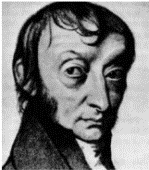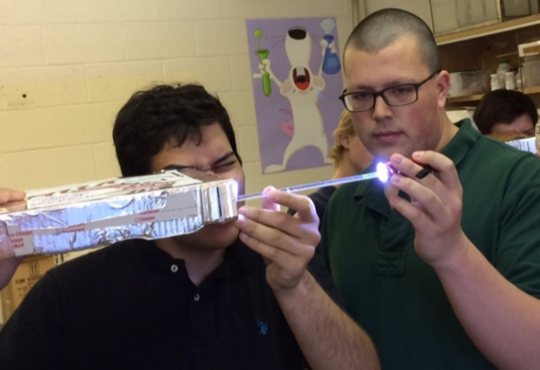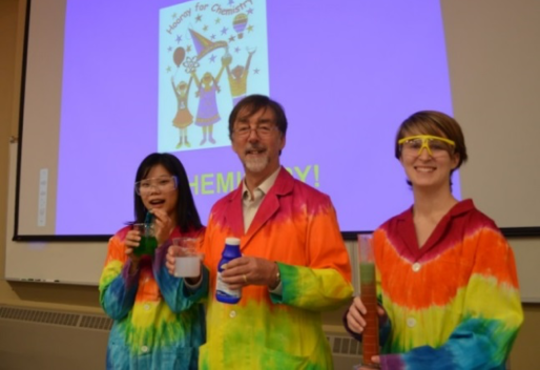 This story of chemistry is about you. You are the valiant chemistry student vigorously searching for love on Valentine’s Day. Along the way, you encounter various inconveniences that you must solve to be victorious in love and in chemistry. Here is your voyage.
This story of chemistry is about you. You are the valiant chemistry student vigorously searching for love on Valentine’s Day. Along the way, you encounter various inconveniences that you must solve to be victorious in love and in chemistry. Here is your voyage.
1) If love at first sight were always spontaneous in thermodynamic terms, which set of thermodynamic variables would describe love?
- ΔG° and ΔH° would be negative values and ΔS° would be a positive value.
- ΔG°, ΔS° and ΔH° would be negative values.
- ΔG° would be a negative value, ΔS° and ΔH° would be positive values.
- ΔG° and ΔS° would be a negative value and ΔH° would be a positive value.
2) In a moment of bad judgment, you post the poster below with your phone number instead of Avogadro’s number. On the first day, you post 2 posters in the basement hallway and get 6 calls per hour until all of your posters are ripped down. On the second day, you post 7 posters in the same area and get 21 calls per hour until all of your posters are ripped down. On the third day you post 3 posters and get 9 calls per hour. Based on this limited set of data, the rate law for the relationship between rate of calls and number of posters is:
- Rate = k [number of posters]
- Rate = [number of posters]2
- Rate = k[number of posters]2
- Rate = [number of posters]
3) You are working on your pick-up lines and think you have come up with a good one: “My love for you is like a Boltzmann distribution: the higher the temperature, the higher my activation energy.” Never mind that the pick-up line is terrible, a friend (well at this point you only have acquaintances left) points out that your pick-up line is theoretically incorrect. What does a Boltzmann distribution curve show?
- The distribution of activation energies for a reaction
- The distribution of particle energies in a reaction
- The distribution of collisions in a reaction
- The distribution of temperatures in a reaction
4) The last pick-up line didn’t work out so well. Then you see your true love who you secretly refer to as phenolphthalein (Phth) and you think “Phth is so cool, molecules stop in Phth’s presence”. In thermodynamics, the state when molecules stop moving in a perfectly ordered crystal is defined by:
- The second Law of Thermodynamics, ΔS = 0 J
- The first Law of Thermodynamics, ΔG = 0 kJ
- The third Law of Thermodynamics, S = 0 J
- The second Law of Thermodynamics, ΔG = 0 kJ
5) You try another pick-up line and this time you are theoretically correct but potentially insulting: “My reaction pathway has a higher activation energy when you are not in the room.” What is present in a reaction system if a reaction mechanism exhibits a second reaction pathway with a lower activation energy?
- A transition state
- An activated complex
- An intermediate
- A catalyst
6) After a bit of an epic fail with the pick-up lines, you finally get Phth to go out with you. You set up a romantic date by candlelight at a fancy restaurant. You are unexpectedly mesmerized by the candle on the table and you start to wonder how long the candle on your table will continue burning. As Phth is telling a childhood story, you consider the fact that paraffin wax burns according to a zero order rate law. The half-life for this zero-order reaction is t1/2 = 540 s. What is the rate constant in the rate law if the initial concentration is 0.100 M? Show your work.
7) Your mind begins to wander to the other thermodynamic properties of combustion. You know that paraffin is a hydrocarbon but the thermodynamic quantities for paraffin are not on your reference table, so you consider the complete combustion of methane:
CH4(g) + 2 O2(g) → CO2(g) + 2H2O(g)
- Calculate the value of ΔS° for this reaction.
- Does the value calculated in part (A) favour spontaneity? How do you know?
- Calculate the value of ΔG° for this reaction. If the formula of paraffin is C20H42, can we approximate the Gibbs Free Energy of the complete combustion of paraffin by multiplying all values by 20? Why or why not?
In the end, the date did not go as smoothly as planned. You figure that if you stick with your chemistry studies you will eventually meet the “you + me → chemistry”.







